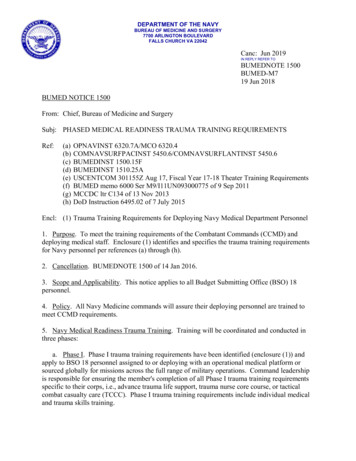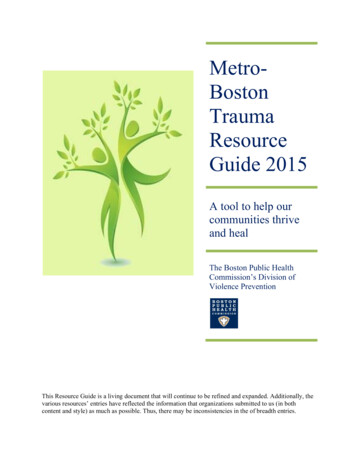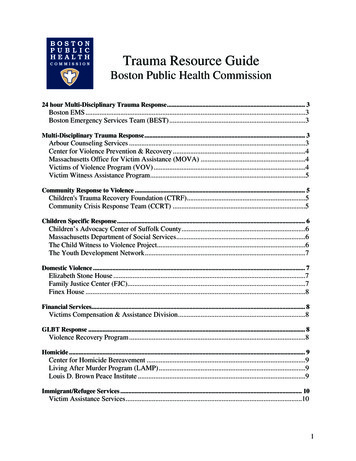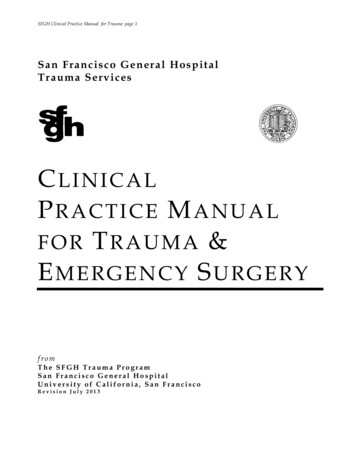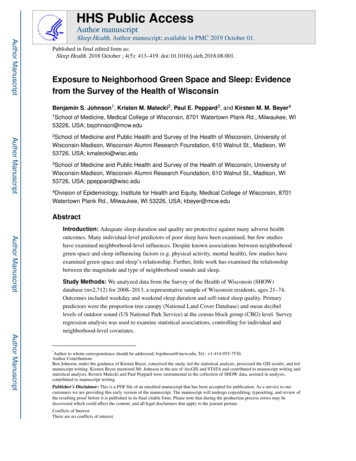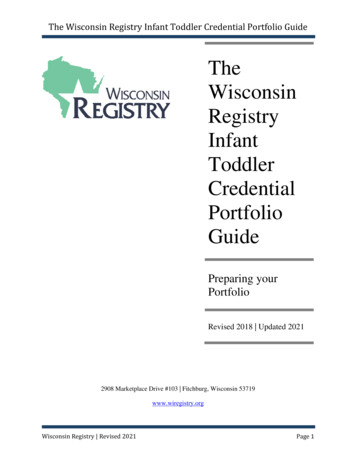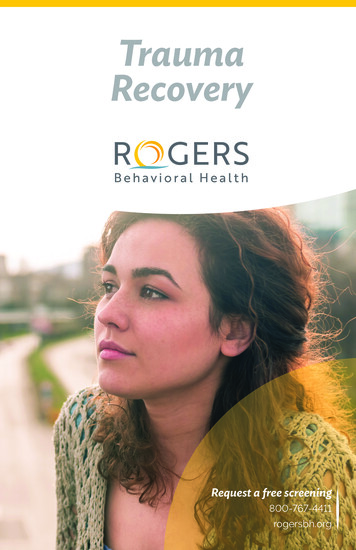
Transcription
TraumaRecoveryRequest a free screening800-767-4411rogersbh.org
Trauma Recoveryat RogersThe effects of trauma and untreated PTSDcause those affected to relive events, avoidthem entirely, or experience heightenedemotions—all of which prevent carrying onwith day-to-day life in a safe and fulfilling way.At Rogers, patients learn to develop successfulcoping strategies to address their trauma andreclaim life.Triggers addressed Sexual and physical assaults during childhoodor adulthood Natural disasters Terrorist attacks Military combat Life-threatening illness, injury, or accidents Secondary trauma (such as first-responder witnessof the aftermath of abuse, accidents, death)Admission starts with a free, confidentialphone screening. To request a screening,call 800-767-4411 or visit rogersbh.org.
An evidence-basedapproachAt Rogers, we use therapeutic methods that research shows tobe the most effective for reducing symptoms. Depending on thelevel of care and diagnosis, patients may engage in:
Cognitive behavioral therapy (CBT)Research shows that CBT is highly effective in helping peoplemake changes in their behaviors, thoughts, and emotions.Rogers is a national leader in the use of CBT.Trauma-focused CBT (TF-CBT)There are still exposure and trauma processing components,but in addition, TF-CBT teaches adolescents skills to cope withdistressing thoughts and feelings and emphasizes making theparent or guardian an active component of treatment.Prolonged exposure (PE)A type of CBT, PE helps patients realize they can encounterstimuli that reminds them of the trauma without fear. Throughengagement in PE alongside a compassionate therapist,patients change their experiences with the event and find safetyin their environments.Art and yoga/movement therapyPatients learn to strengthen coping skills while connecting andexpressing thoughts in many ways.Family involvementHaving family participation is a key part of recovery that allowsfor more effective treatment and eases the transition aftertreatment. This includes psychoeducation for family membersabout their loved one’s symptoms and treatment strategiesbeing used.
Levels of careInpatient CareTo help patients with acute needs for medical stabilization,Rogers offers inpatient care at three hospital locations insoutheastern Wisconsin: Brown Deer, Oconomowoc,and West Allis.Outpatient CarePartial Hospitalization Care (PHP)6 hours a day, 5 days a weekIntensive, structured treatment that provides more hours oftherapy in a week and allows patients to remain connected withtheir social support network. On average, PHP treatment lastsfour to six weeks.Intensive Outpatient Care (IOP)3 hours a day, 4 to 5 days a weekSpecialized, short-term treatment to alleviate symptoms, andto assist patients with the transition between PHP care andtraditional outpatient treatment. On average, IOP treatmentlasts four to six weeks.
Treatment and level of care will bedetermined upon medical staff review.Program availability varies by location.
Levels of careResidential CareTo provide those suffering with intense effects of trauma andPTSD, Rogers is proud to offer trauma recovery residential carein Oconomowoc. In this new supportive, home-like setting,patients will work with treatment teams to develop skillsneeded to face challenges and find the resilience to achieveand maintain recovery.
Outcomes DataFor more than 20 years, Rogers has been measuring theeffectiveness of our care in the most transparent, scientificallyreliable way possible.Each year, Rogers conducts nearly a million patientassessments: taken at the start of treatment, at various pointsthroughout treatment, at discharge, and 12 months after care.Our research team analyzes this data to adjust individualtreatment plans based on a patient’s progress during treatment,evaluate the effectiveness of each program, and replicate thetherapies and approaches that get the best results for ourpatients across the Rogers system.Clinical Global Impressions-Improvement (CGI)Clinician-rated assessment of patient severity upon admissionand assessment of improvement at time of discharge. 91% ofour patients were minimally, much, or very much improvedby the end of their treatment, as rated by the attendingpsychologist or psychiatrist.1% 2%6%Saw improvementNo change91%Saw worsening symptomsNot assessed
PTSD Symptom Checklist (Civilian) 5.0 (PCLv)This 20-item self-report assesses the symptoms of PTSD incivilians. The goal is to decrease the severity of symptoms forthose we treat. The higher the number, the more severe thesymptoms. This data shows that patients see a reduction insymptoms at the time of discharge.Adult partial hospitalization results807060535038403020100AdmissionDischarge0-32 Subclinical33-80 ClinicalTo see the results of evidencebased treatment at Rogers, visitrogersbh.org/outcomes.
To get startedAdmission starts with a free, confidential phonescreening. To request a screening, call 800-767-4411or visit rogersbh.org.Our MissionWe provide highly effective mental health andaddiction treatment that helps people reach their fullpotential for health and well-being.LocationsFor more information on the services nearest you,visit rogersbh.org/locations.CaliforniaLos AngelesSan DiegoSan isconsinAppletonBrown DeerKenoshaMadisonOconomowocWest AllisMinneapolisSt. PaulMKT139-719
Trauma Recovery Request a free screening 800-767-4411 rogersbh.org. Trauma Recovery at Rogers . San Diego San Francisco Florida Miami Tampa Illinois Hinsdale Skokie Minnesota Minneapolis St. Paul Pennsylvania Philadelphia Tennessee Nashville Wisconsin Appleton Brown Deer Kenosha Madison Oconomowoc


